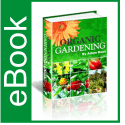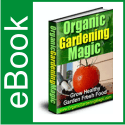Gardening in Limited Space
Gardening in Limited Space
Article by Samet Bilir
Many people enjoy the flavor and quality of garden fresh vegetables as well as a feeling of accomplishment from growing their own. Busy lifestyles, both family members working, and limited space of urban lots creates a need for an approach other than traditional vegetable gardening. As a result, gardeners want good production from limited space which may even include containers on patios, decks or balconies. There are several space-saving gardening methods that may be used.
Old English gardeners devised the idea of interplanting vegetables to utilize space more fully. Interplanting means that a quick-growing, early maturing crop is planted between rows of a later-maturing crop that will later enlarge to fill the entire space. The crops may be planted in alternate rows, or may alternate in the same row. Some combinations suitable for early garden interplanting would be radishes with leaf lettuce, beets with carrots, or onions with cabbage. Vining crops or tomatoes may be added between rows of early crops that will then expand into the space as the early crops are harvested. The gardener may discover other combinations suitable for favorite vegetables or the conditions of the garden space.
Another space-saving technique is known as succession planting. This method achieves continuous use of a small space since a new crop is planted immediately after an earlier one is harvested. This is usually done by following a cool season crop with a warm season crop. They do not usually exist in the same area at the same time. Lettuce, peas, radishes or onions may be harvested in late spring or early summer with plenty of time to clean up the area and follow with green bush beans or late sweet corn. Fall crops, such as turnips or fall cabbage, might follow potatoes, earlier corn or any of the spring crops.
Band planting is another technique in which crops are planted in closely spaced double or triple rows instead of single rows. This reduces the amount of space in paths. It is best suited to low-growing crops such as lettuce, cabbage or bush beans.
Raised-bed gardening is another space-saving technique. Beds which are small enough to be worked from the perimeter are built from 8 to 12 inches high. Good top soil or soil mixes high in organic matter are used to fill them. Since the gardener does not have to walk into them, plants are set or seeded close enough so leaves will touch as they reach maturity. A layer of mulch will keep down weeds and as plants grow, they will be close enough to shade out weeds. Competition between closely spaced vegetable plants is more intense. Therefore, irrigation during dry periods is important to keep up an adequate water supply. If a mulch is not used, some shallow cultivation may be necessary to keep down weeds. When hoeing out weeds, do not dig deeply. Normally, a shaving stroke digging no more than 1/4 to 1/2 inch deep should be adequate to keep down weeds and avoid root damage to the vegetables.
Another development that has helped gardeners with limited space has been the breeding of vegetables that are compact and require less space while still producing a good crop. Bush cucumbers and bush watermelons are examples of crops that require much less space than standard varieties. These vegetable varieties are suitable for those who are trying to grow vegetables in planters or containers on patio, balcony or deck.
Vertical gardening is another approach, although not necessarily one of low maintenance. Fences, cages, trellises or other supports may be used to grow plants upright rather than spreading. Staking tomatoes has been one of the most common approaches to this technique. Vining crops are particularly suited to supports which will reduce their spread over the soil surface. Vining beans, cucumbers, squash and melons may be grown in this way. Some larger melons may be grown on supports, but individual melons will need support as they enlarge because of the weight. If not supported, large melons may break off or pull down the vines before they are mature.
Good fertility is important for intensive gardening techniques. Close spacing causes more root competition for fertility as well as water. In preparation for planting use about 3 to 4 pounds of a garden fertilizer such as 12-12-12 for each 100 square feet of garden area and work into the soil thoroughly. For very small gardens, this would reduce to about a tablespoon per square foot.
If vegetables grown from seeds germinate too thickly, never be afraid to thin them for adequate spacing. While intensive gardening means placing plants close together, extremely crowded plants will not produce the quantity of a crop that is expected.
About the Author
Samet Bilir is a hobbyist gardener and landscaper with more than 10 years of experience in vegetables gardening. Among other projects, he is co-owner of gardeningandlandscapedesign.com, a great website to learn how to start a garden with subjects like: home vegetable gardens, container and raised beds gardening, growing tomatoes, herb and flower gardening and many more.
Use and distribution of this article is subject to our Publisher Guidelines
whereby the original author’s information and copyright must be included.

 September 29, 2012
September 29, 2012 







